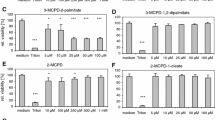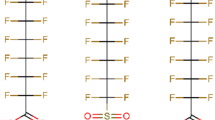Abstract
Furan fatty acids (furan-FA) are oxidative products of conjugated linoleic acids (CLA) and may therefore be ingested when CLA-containing food or food-additives are consumed. Due to the presence of a furan ring structure the question arises whether furan-FA may have toxic properties on enterocytes and liver cells. Here we show that furan-FA neither have toxic effects in human colon cancer cell line Caco-2 nor in human hepatoma cell line HepG2 at concentrations that could be relevant for humans. At concentrations up to 100 μM, all tested furan-FA isomers showed no pronounced cytotoxicity and did not affect cellular proliferation or apoptosis up to concentrations of 500 μM. In addition, furan-FA was neither genotoxic in the micronucleus test using Chinese hamster lung fibroblasts (V79) nor in the Ames test independent of the presence or absence of rat liver homogenate for enzymatic activation of the furan ring structure. A proteomic approach revealed that 48 proteins were differentially expressed when Caco-2 cells were incubated with up to 1 mM of 10,13-epoxy-10,12-octadecadienoic acid (10,12-furan-FA). Three of the 30 proteins that could be identified by MALDI-TOF analysis were upregulated and were associated with lipid droplet biogenesis. The remaining 27 proteins were downregulated and were considered to be associated with general cellular processes such as DNA replication and transcription, protein biosynthesis and protein processing, lipid and energy metabolism. From the proteomic data we conclude that furan-FA is predominantly stored in lipid droplets thereby downregulating cellular metabolic activity and driving the cells into a state of rest.




Similar content being viewed by others
Abbreviations
- 2-DE:
-
Two-dimensional polyacrylamide gel electrophoresis
- CLA:
-
Conjugated linoleic acid
- Furan-FA:
-
Furan fatty acid
- IEF:
-
Isoelectric focusing
- IPG:
-
Immobilized pH gradient
- MALDI-TOF:
-
Matrix-assisted laser desorption ionisation-time of flight
- ER:
-
Endoplasmic reticulum
References
Kepler CR, Hirons KP, McNeill JJ, Tove SB (1966) Intermediates and products of the biohydrogenation of linoleic acid by Butyrivibrio fibrisolvens. J Biol Chem 241:1350–1354
Kepler CR, Tucker WP, Tove SB (1970) Biohydrogenation of unsaturated fatty acids. IV. Substrate specificity and inhibition of linoleate delta-12-cis, delta-11-trans-isomerase from Butyrivibrio fibrisolvens. J Biol Chem 245:3612–3620
Ha YL, Grimm NK, Pariza MW (1987) Anticarcinogens from fried ground beef: heat-altered derivatives of linoleic acid. Carcinogenesis 8:1881–1887
Truitt A, McNeill G, Vanderhoek JY (1999) Antiplatelet effects of conjugated linoleic acid isomers. Biochim Biophys Acta 1438:239–246
Kritchevsky D, Tepper SA, Wright S, Tso P, Czarnecki SK (2000) Influence of conjugated linoleic acid (CLA) on establishment and progression of atherosclerosis in rabbits. J Am Coll Nutr 19:472S–477S
Lee KN, Kritchevsky D, Pariza MW (1994) Conjugated linoleic acid and atherosclerosis in rabbits. Atherosclerosis 108:19–25
Nicolosi RJ, Rogers EJ, Kritchevsky D, Scimeca JA, Huth PJ (1997) Dietary conjugated linoleic acid reduces plasma lipoproteins and early aortic atherosclerosis in hypercholesterolemic hamsters. Artery 22:266–277
O’Shea M, Bassaganya-Riera J, Mohede IC (2004) Immunomodulatory properties of conjugated linoleic acid. Am J Clin Nutr 79:1199S–1206S
Baddini FA, Fernandes PA, da Ferreira CN, Goncalves RB (2009) Conjugated linoleic acid (CLA): effect modulation of body composition and lipid profile. Nutr Hosp 24:422–428
Clement L, Poirier H, Niot I, Bocher V, Guerre-Millo M, Krief S, Staels B, Besnard P (2002) Dietary trans-10,cis-12 conjugated linoleic acid induces hyperinsulinemia and fatty liver in the mouse. J Lipid Res 43:1400–1409
Riserus U, Vessby B, Arnlov J, Basu S (2004) Effects of cis-9,trans-11 conjugated linoleic acid supplementation on insulin sensitivity, lipid peroxidation, and proinflammatory markers in obese men. Am J Clin Nutr 80:279–283
Chung S, Brown JM, Provo JN, Hopkins R, McIntosh MK (2005) Conjugated linoleic acid promotes human adipocyte insulin resistance through NFkappaB-dependent cytokine production. J Biol Chem 280:38445–38456
Yurawecz MP, Hood JK, Mossoba MM, Roach JA, Ku Y (1995) Furan fatty acids determined as oxidation products of conjugated octadecadienoic acid. Lipids 30:595–598
Lu SC, Huang HY (1994) Comparison of sulfur amino acid utilization for GSH synthesis between HepG2 cells and cultured rat hepatocytes. Biochem Pharmacol 47:859–869
Urani C, Doldi M, Crippa S, Camatini M (1998) Human-derived cell lines to study xenobiotic metabolism. Chemosphere 37:2785–2795
Lampen A, Bader A, Bestmann T, Winkler M, Witte L, Borlak JT (1998) Catalytic activities, protein- and mRNA-expression of cytochrome P450 isoenzymes in intestinal cell lines. Xenobiotica 28:429–441
Wenzel U, Nickel A, Daniel H (2005) Increased carnitine-dependent fatty acid uptake into mitochondria of human colon cancer cells induces apoptosis. J Nutr 135:1510–1514
Gorg A, Obermaier C, Boguth G, Harder A, Scheibe B, Wildgruber R, Weiss W (2000) The current state of two-dimensional electrophoresis with immobilized pH gradients. Electrophoresis 21:1037–1053
Bradford MM (1976) A rapid and sensitive method for the quantitation of microgram quantities of protein utilizing the principle of protein-dye binding. Anal Biochem 72:248–254
Rabilloud T (2000) Detecting proteins separated by 2-D gel electrophoresis. Anal Chem 72:48A–55A
Shevchenko A, Wilm M, Vorm O, Mann M (1996) Mass spectrometric sequencing of proteins silver-stained polyacrylamide gels. Anal Chem 68:850–858
EFSA Panel on Dietetic Products NaA (2010) Opinion on the safety of “conjugated linoleic acid (CLA)-rich oil” as a novel food ingredient. EFSA J 8:1601–1642
Chen LJ, Hecht SS, Peterson LA (1995) Identification of cis-2-butene-1,4-dial as a microsomal metabolite of furan. Chem Res Toxicol 8:903–906
Kedderis GL, Carfagna MA, Held SD, Batra R, Murphy JE, Gargas ML (1993) Kinetic analysis of furan biotransformation by F-344 rats in vivo and in vitro. Toxicol Appl Pharmacol 123:274–282
Parmar D, Burka LT (1993) Studies on the interaction of furan with hepatic cytochrome P-450. J Biochem Toxicol 8:1–9
Byrns MC, Predecki DP, Peterson LA (2002) Characterization of nucleoside adducts of cis-2-butene-1,4-dial, a reactive metabolite of furan. Chem Res Toxicol 15:373–379
Byrns MC, Vu CC, Neidigh JW, Abad JL, Jones RA, Peterson LA (2006) Detection of DNA adducts derived from the reactive metabolite of furan, cis-2-butene-1,4-dial. Chem Res Toxicol 19:414–420
Heppner CW, Schlatter JR (2007) Data requirements for risk assessment of furan in food. Food Addit Contam 24(Suppl 1):114–121
Glatt H, Schneider H, Liu Y (2005) V79-hCYP2E1-hSULT1A1, a cell line for the sensitive detection of genotoxic effects induced by carbohydrate pyrolysis products and other food-borne chemicals. Mutat Res 580:41–52
Peterson LA, Naruko KC, Predecki DP (2000) A reactive metabolite of furan, cis-2-butene-1,4-dial, is mutagenic in the Ames assay. Chem Res Toxicol 13:531–534
Durling LJ, Svensson K, Abramsson-Zetterberg L (2007) Furan is not genotoxic in the micronucleus assay in vivo or in vitro. Toxicol Lett 169:43–50
Kellert M, Brink A, Richter I, Schlatter J, Lutz WK (2008) Tests for genotoxicity and mutagenicity of furan and its metabolite cis-2-butene-1,4-dial in L5178Y tk ± mouse lymphoma cells. Mutat Res 657:127–132
Mugford CA, Carfagna MA, Kedderis GL (1997) Furan-mediated uncoupling of hepatic oxidative phosphorylation in Fischer-344 rats: an early event in cell death. Toxicol Appl Pharmacol 144:1–11
Moser GJ, Foley J, Burnett M, Goldsworthy TL, Maronpot R (2009) Furan-induced dose-response relationships for liver cytotoxicity, cell proliferation, and tumorigenicity (furan-induced liver tumorigenicity). Exp Toxicol Pathol 61:101–111
Chen T, Mally A, Ozden S, Chipman JK (2010) Low doses of the carcinogen furan alter cell cycle and apoptosis gene expression in rat liver independent of DNA methylation. Environ Health Perspect 118:1597–1602
Fransson-Steen R, Goldsworthy TL, Kedderis GL, Maronpot RR (1997) Furan-induced liver cell proliferation and apoptosis in female B6C3F1 mice. Toxicology 118:195–204
Lampen A, Leifheit M, Voss J, Nau H (2005) Molecular and cellular effects of cis-9, trans-11-conjugated linoleic acid in enterocytes: effects on proliferation, differentiation, and gene expression. Biochim Biophys Acta 1735:30–40
Cho HJ, Kwon GT, Park JH (2009) Trans-10,cis-12 Conjugated linoleic acid induces depolarization of mitochondrial membranes in HT-29 human colon cancer cells: a possible mechanism for induction of apoptosis. J Med Food 12:952–958
Kim EJ, Holthuizen PE, Park HS, Ha YL, Jung KC, Park JH (2002) Trans-10, cis-12-conjugated linoleic acid inhibits Caco-2 colon cancer cell growth. Am J Physiol Gastrointest Liver Physiol 283:G357–G367
Park HS, Chun CS, Kim S, Ha YL, Park JH (2006) Dietary trans-10, cis-12 and cis-9,trans-11 conjugated linoleic acids induce apoptosis in the colonic mucosa of rats treated with 1,2-dimethylhydrazine. J Med Food 9:22–27
Mougios V, Matsakas A, Petridou A, Ring S, Sagredos A, Melissopoulou A, Tsigilis N, Nikolaidis M (2001) Effect of supplementation with conjugated linoleic acid on human serum lipids and body fat. J Nutr Biochem 12:585–594
Buhrke T, Merkel R, Lengler I, Lampen A (2012) Absorption and metabolism of cis-9,trans-11-CLA and of its oxidation product 9,11-furan fatty acid by Caco-2 cells. Lipids 47:435–442
Miura S, Gan JW, Brzostowski J, Parisi MJ, Schultz CJ, Londos C, Oliver B, Kimmel AR (2002) Functional conservation for lipid storage droplet association among Perilipin, ADRP, and TIP47 (PAT)-related proteins in mammals, Drosophila, and Dictyostelium. J Biol Chem 277:32253–32257
Yamaguchi T, Omatsu N, Omukae A, Osumi T (2006) Analysis of interaction partners for perilipin and ADRP on lipid droplets. Mol Cell Biochem 284:167–173
Soni KG, Mardones GA, Sougrat R, Smirnova E, Jackson CL, Bonifacino JS (2009) Coatomer-dependent protein delivery to lipid droplets. J Cell Sci 122:1834–1841
Hoege C, Pfander B, Moldovan GL, Pyrowolakis G, Jentsch S (2002) RAD6-dependent DNA repair is linked to modification of PCNA by ubiquitin and SUMO. Nature 419:135–141
Arvand A, Bastians H, Welford SM, Thompson AD, Ruderman JV, Denny CT (1998) EWS/FLI1 up regulates mE2-C, a cyclin-selective ubiquitin conjugating enzyme involved in cyclin B destruction. Oncogene 17:2039–2045
McLennan AG (2006) The Nudix hydrolase superfamily. Cell Mol Life Sci 63:123–143
Kamiya H, Hori M, Arimori T, Sekiguchi M, Yamagata Y, Harashima H (2009) NUDT5 hydrolyzes oxidized deoxyribonucleoside diphosphates with broad substrate specificity. DNA Repair (Amst) 8:1250–1254
Myers RW, Wray JW, Fish S, Abeles RH (1993) Purification and characterization of an enzyme involved in oxidative carbon–carbon bond cleavage reactions in the methionine salvage pathway of Klebsiella pneumoniae. J Biol Chem 268:24785–24791
Wray JW, Abeles RH (1995) The methionine salvage pathway in Klebsiella pneumoniae and rat liver. Identification and characterization of two novel dioxygenases. J Biol Chem 270:3147–3153
Coe H, Michalak M (2009) Calcium binding chaperones of the endoplasmic reticulum. Gen Physiol Biophys 28 Spec No Focus F96–F103
Rojas E, Arispe N, Haigler HT, Burns AL, Pollard HB (1992) Identification of annexins as calcium channels in biological membranes. Bone Miner 17:214–218
Benes P, Vetvicka V, Fusek M (2008) Cathepsin D-many functions of one aspartic protease. Crit Rev Oncol Hematol 68:12–28
Ho MS, Tsai PI, Chien CT (2006) F-box proteins: the key to protein degradation. J Biomed Sci 13:181–191
Steinbrenner H, Sies H (2009) Protection against reactive oxygen species by selenoproteins. Biochim Biophys Acta 1790:1478–1485
Acknowledgments
We thank Linda Brandenburger, Brigitte Finke, Anja Köllner, Christine Meckert, and Marlies Sagmeister for technical assistance. This work was funded by the Deutsche Forschungsgemeinschaft (DFG project LA 1177/5-4).
Author information
Authors and Affiliations
Corresponding author
About this article
Cite this article
Lengler, I., Buhrke, T., Scharmach, E. et al. In-Vitro Toxicological and Proteomic Analysis of Furan Fatty Acids Which are Oxidative Metabolites of Conjugated Linoleic Acids. Lipids 47, 1085–1097 (2012). https://doi.org/10.1007/s11745-012-3713-y
Received:
Accepted:
Published:
Issue Date:
DOI: https://doi.org/10.1007/s11745-012-3713-y




